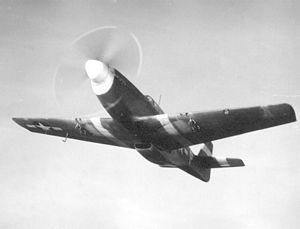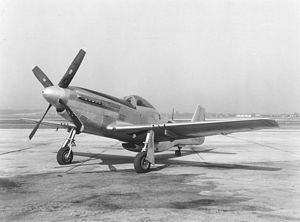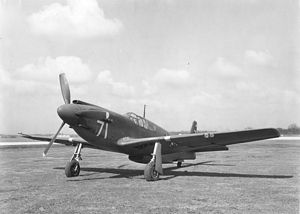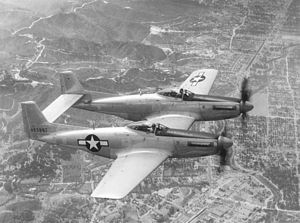North American P-51 Mustang
Generally considered the best fighter of WWII
By Stephen Sherman, Apr. 2002. Updated Sept. 26, 2012.
North American Aviation originally designed the Mustang in response to a British specification. They agreed to produce the first prototype only 4 months after signing the contract in April 1940.
A Better Engine
In April, 1942, a British test pilot, Ronald Harker, flew the Mustang and was very impressed by it. He suggested that the new plane would be a natural fit with the Rolls Royce Merlin 60-series engine, well-suited to high altitudes. At the prodding of Major Thomas Hitchcock, the Americans began working along the same lines (using the Packard license-built version of the Merlin), and the first Merlin-equipped Mustang, the P-51B, flew in November, 1942. The results were impressive, to say the least. At 30,000 feet, the improved Mustang reached 440 MPH, almost 100 MPH faster than the Allison-equipped Mustang at that altitude.
Both Robert Goebel and Bud Anderson flew Mustangs. Their comments follow.
Bob Goebel on the P-51:
Robert Goebel flew Mustangs with the 31st Fighter Group, based at San Severo, Italy, in the MTO (Mediterranean Theater of Operations). Like Bud Anderson, he had flown P-39s earlier on. At San Severo in Spring 1944, he got his first crack at the P-51:
We soon found out that the P-51 Mustang was indeed a different breed of airplane. It was fast, for one thing. ... The P-51 was red-lined at 505 and, though it was no Spitfire, its turning ability wasn't bad at all - especially if you sneaked down 10 degrees of flaps. It was pretty good in the climbing department too, and accelerated very fast in a dive. But the thing that really set the Mustang apart from any other fighter, friend or foe, was its range. With a 75-gallon tank slung under each wing, it could perform the unheard-of: It could fly six-hour missions.
Physically, it was pleasing to the eye and looked fast, even sitting on the ground. Power was provided by a V-1650 Rolls-Royce Merlin engine built under license in the States by Packard, the luxury automobile company. The V-1650 was a fine engine and could be taken up to 61 inches of manifold pressure at 3,000 RPM for take-off or, if needed in combat, 67 inches for up to five minutes in Emergency Power. Normally aspirated engines tended to run out of power as altitude increased, usually between 15,000 and 20,000 feet.
The P-51 had a two-stage blower in the induction system that was controlled automatically with a barometric switch. Around 17,000 feet, when the throttle had been advanced almost all the way forward just to maintain normal cruise, the blower would kick into high, the manifold pressure would jump up, and the climb could be continued to 30,000 feet. The P-51 could be taken a lot higher than that, but above 30,000 feet the power was way down and the controls had to be handled gingerly.
quoted from Mustang Ace available at Amazon.com
Bud Anderson on the P-51:
When Bud Anderson arrived at Raydon Wood in England, with the 357th Fighter Group, he was introduced to the Mustang, which was a lot different from the P-39. The Mustang was a tail-dragger with a long nose blocking the pilot's forward view, requiring him to make sweeping "S" turns to see where he was going. The P-51 was a lot more powerful, and had a big four-blade paddle propeller. Take-offs and landing were a bit tricky, but in the air:
[The Mustang] was pleasant and forgiving to fly. Best of all, it went like Hell. The Merlin had great gobs of power, and was equally at home high or low, thanks to a two-stage, two-speed supercharger. The Mustang carried fuel enough to pursue and destroy the enemy once you'd flown to the target, and it could turn on a dime. It was crucial to keep it it trim but, as we gained experience with the plane, that became automatic. We sensed it was special, even before we measured it against what the enemy pilots were flying.
quoted from To Fly and Fight, Memoirs of a Triple Ace, by Clarence 'Bud' Anderson
The Mustang's range and combat capabilities permitted it to escort the heavy USAAF bombers (B-17s mostly) on massive daylight bombing raids over Germany. Some have argued that it was a "war-winning" weapon. It certainly was a decisive factor in the aerial Battle of Germany. After World War Two, the Mustang continued to serve with the USAF and other Western air forces, including distinguished service in the Korean War.
Mustang Chronology
June '40 - British Request
In the Spring of 1940, the British Purchasing Commission, headed by Sir Henry Self, visiting the U.S. asked Dutch Kindelberger, head of North American Aviation, to build Curtiss-designed P-40's for them. While his company had never built a fighter, Kindelberger's designers, led by Edgar Schmued had started design work on a modern fighter. Already, in 1940, the Curtiss P-40 and the Bell P-39 were inferior to aircraft being flown by Germany and Britain. Kindelberger offered to design and build the first prototype of the new fighter in 120 days. They signed the contract for 300 of the aircraft in late May.
The new fighter incorporated many of the latest developments in aeronautics, notably the laminar flow wing, a wing that was relatively symmetrical and offered less drag at high speed. The wings were designed to be easy to manufacture, with only two spars. As specified by the British requirement, the new airplane, designated the NA-73X, employed an in-line engine; the Allison V-1710 fit the bill, although it lacked a turbo-supercharger for high-altitude performance. The main wheels were set twelve feet apart, for good stability on landing.
In the original design, the British required eight machine guns: four .30 caliber and four .50 caliber. Ultimately, most Mustangs would carry the usual American weaponry of six .50 caliber Brownings. It carried twice as much internal fuel as a Spitfire, 180 gallons in self-sealing wing tanks.
102 days after contract signing, in Sept. 1940, the protoype NA-73X rolled out. Apparently no one quibbled over the fact that it didn't have an engine, nor brakes, nor paint, nor actual gun mounts.
Oct. '40 - Flight of NA-73X Prototype
Oct. '41 - Mustang Mark I Reaches Britain
While North American (NAA) had developed the prototype quickly, the first stage of production moved along more slowly. The first NA-73 production aircraft did not fly until April 23, 1941, six months after NA-73X. It carried no weapons and was kept by NAA for testing and development. The second production airplane (armed with four .30's and four .50's) arrived in Liverpool in October, 1941 - a year after the prototype's first flight.Nonetheless, the Mustang was so promising that in late 1941 the RAF ordered another 300 and the USAAF 150. As the exigencies of war demanded, 93 of these 150 (factory designated NA-91) ended up in British service, as Mustang IA's, equipped with four 20mm cannon. The remaining 57, equipped with four .50 caliber machine guns, and known as P-51's, ended up in US service.
Feb. '42 - Tactical Recon: No. 26 Sqn Issued Mark I's
These early Allison-powered Mustangs were fast, strongly constructed, had a long range, and packed a wallop with their eight guns. But their poor high-altitude performance relegated them to the low-level tactical reconnaissance role with British Army Cooperation Command (ACC). Outfitted with a K24 camera behind the pilot, the Mark I Mustangs could photograph enemy dispositions, provide ground support, and fight their way out of a jam. And they could do so better than the ACC's existing Tomahawks and Lysanders. By summer 1942, 15 RAF squadrons were flying the Mark I, photographing invasion targets, shooting up trains, barge-busting, and probing German defenses.
July '42 - First Long Range Recon Mission
On July 27, sixteen RAF Mustangs undertook a long-range reconnaissance mission, photographing the Dortmund-Ems Canal.
Aug. '42 - Dieppe Raid
The "reconnaissance in force" on August 19 gained little for the Allies, except the expensive and bloody lesson in how tough the German defenses were, both on the ground and in the air. The raid, Operation Jubilee, introduced the Typhoon and the Spitfire Mk. IX, and marked the first Mustang aerial victory. Four Mustang squadrons, No. 26, 239, 400, and 414, provided tactical recon for the ground troops.
Flight Officer Hollis "Holly" Hills, an American serving with No. 414 Sqn of the RCAF, took off from Gatwick in the pre-dawn darkness, as "weaver" (wingman) to Flt. Lt. Freddie Clarke. Flying at wavetop level, the glow from the searchlights and AA fire at Dieppe permitted him to stay with his leader. Once over the target, they were promptly separated; both returned safely. On the second mission that morning, they saw a huge dogfight filling the sky over Dieppe, and Hills spotted four Fw 190s off to their right. With his radio out and unaware of the German fighters, Flt. Lt. Clarke left himself open and was hit. Then Hollis caught one of the FW's with a deflection burst. It started smoking and flaming, then the canopy popped off. Hollis fired again, and the plane fell to ground. He headed for home, shepherding Clarke as he went, dueling another Fw 190 for miles. In his fight with the Fw's, he lost sight of Clarke. After that, Hollis flew home uneventfully, to a dinner made rather somber by Clarke's apparent loss. But next morning, Clarke re-appeared over Hollis' bunk, smelling of seaweed; he had ditched off Dieppe and been rescued. He had witnessed and could officially confirm Hollis' victory over the Focke-Wulf, the first of many aerial victories for the Mustang. And Clarke had the dubious honor of being the first combat Mustang to be shot down in the war by the Germans.
Read more about Clarke's and Hills' mission in this email from Clarke's son.
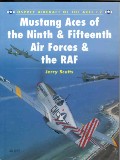 Mustang Aces of the Ninth and Fifteenth Air Forces and
the RAF tells more about Dieppe and the RAF's use of the
Mustang.
Mustang Aces of the Ninth and Fifteenth Air Forces and
the RAF tells more about Dieppe and the RAF's use of the
Mustang.
Oct. '42 - the Merlin Engine
As early as May, 1942, Ronald Harker, a Rolls Royce test pilot, first recommended mating the Mustang airframe to the Merlin engine, an idea which would transform the P-51 into a decisive weapon, capable of escorting American bombers all the way to Berlin. Harker test-flew an RAF Mustang on April 30, 1942, and noted that it was 30 MPH faster than the Spitfire Mk V and had almost double the range. Harker's memo recommending the Merlin-Mustang combination (in which he erroneously identified Edgar Schmued as a former Messerschmitt employee) got the attention of Rolls Royce management, who borrowed five RAF Mustangs to test the idea. The British flight-tested the Mustang X in October, and found that the experimental craft significantly out-performed the Allison at high altitudes, generating 200 more horsepower at 20,000 feet and almost 500 more HP at 30,000 feet. While the British research was valuable, the American Merlin Mustang program proceeded almost independently.
In the summer of 1942, Packard Motors was negotiating with Rolls
Royce to license-build the Merlin engine at its Detroit plant. Learning
of Rolls Royce' Merlin-Mustang plans, Major Thomas Hitchcock, the
American military attache in London, and others, pushed for the
development of a Mustang powered by the Packard-built Merlin.
Authorized in July, 1942, North American began its Merlin Mustang
development in August.
The XP-51B included these changes:
- a Packard Merlin engine, instead of the Allison V-1710
- a four-bladed propeller
- stronger underwing racks
- a strengthened airframe
- a relocated carburetor air intake, from above to below the nose, as
shown below
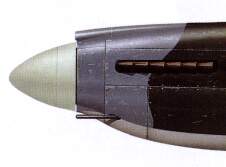

© Osprey Publishing Ltd, www.ospreypublishing.com - an intercooler radiator
- larger ducts and doors for the radiator system
- a deeper scoop under the rear fuselage
- removal of the nose-mounted guns - (see illustration above)
The USAAF, desperately needing a long-range bomber escort, contracted for 2200 P-51B's. North American geared up for Mustang production, moving the B-25 program to Kansas City, dedicating the Inglewood plant to the Mustang, and expanding the Dallas plant for the Mustang (Dallas-built versions of the -B model were designated P-51C). P-51B's began rolling out of Inglewood in May, 1943; eventually 1,990 of the -B models would be made. The first of 1,750 P-51C's produced at Dallas flew in August.
After production of the B/C model began, three more changes appeared:
- an up-rated Packard Merlin engine, the 1650-7 replacing the 1650-3, for a small increase in HP
- an 85 gallon fuel tank installed behind the pilot, giving critically longer reach, but moving the center of gravity aft, thus reducing directional stability until most of the fuel was consumed
- the bulbous Malcolm hood, giving much better all-around
visibility (a field modification), as shown below


© Osprey Publishing Ltd, www.ospreypublishing.com
June '43 - A-36's with USAAF in MTO, Sicily
The first U.S. unit to fly the Mustang in combat was the Morocco-based 154th Observation Squadron, which used 35 P-51-2NA's for a few weeks in April-May, 1943.300 A-36A's (a variant of the Mustang known as "Apache" and "Invader") made a larger impact, when the 27th and 86th Bombardment Groups began flying them. In June, 1943, the 27th BG flew missions against Pantelleria, in the build-up for the Sicily invasion. Dive bombing was a challenge, the recommended technique being a dive from 8,000 - 10,000 feet at 90 degrees, with dive brakes extended to keep speed below 400 MPH. At 3,000 feet, the pilot dropped two 500-pound bombs and pulled out at 1,500 feet. With this extended straight-in bomb run, they were vulnerable to anti-aircraft fire.
German and Italian fighters engaged also engaged them. One A-36 pilot, Lt. Mike Russo of the 27th BG, made ace, the only man to do so while flying an Allison-powered Mustang. He counted four different types among his five aerial victories: two Fw-190's, a Bf-109, a Ju-52, and a Fieseler Storch.
The 27th and 86th were reduced to three squadrons each in September, due to the heavy losses they had incurred. As the Italian campaign progressed, they increasingly used strafing and glide bombing tactics, which reduced their losses to flak. In early 1944, both Groups transitioned to P-47's and turned over their A-36's for training.
Continue with P-51 Mustang, page 2





